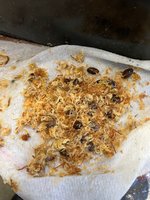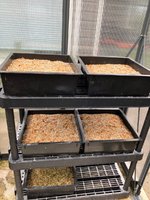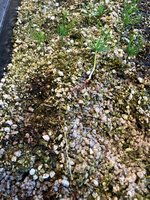River's Edge
Imperial Masterpiece
Started the process to improve the availability of JWP for the next generation. Personally I have found it very difficult to acquire JWP on their own roots. After a recent trip to Kokufu and seeing the amazing trees I decided this material should be available. With the help of a BNut member who currently lives in Japan I was able to source some seeds to begin the process. Thanks to " Yamabudoudanshi" for his valuable assistance. This thread will document the process and progress. Given my age I expect the will be transferring to new enthusiasts sooner rather than later in development. My goal will be to set the basic nebari and trunk structure for an interesting foundation to work with.
I began with th purchase of some JWP seeds from a reputable seller in Japan. Due to the small size of the personal purchase it was possible to complete the correct paperwork for customs and importation without too much difficulty. They were shipped and passed through the proper channels without too much delay. The shipping and processing time was approximately two weeks.
I was fortunate to be provided with good information regarding the seeds, it was important to know when and where they were collected and how they were stored. Certain areas in Japan are noted for five needle pine with certain desirable characteristics.
1. Once the seeds arrived I began the cold stratification process after soaking for a period of 90 days. During this time I checked them every two weeks to ensure the proper moisture levels and towards the end of the period to check for sprouting! The seeds were packed in damp paper towel with shredded sphagnum moss, and then sealed in zip loc baggies. I split the seeds into four zip loc baggies of 50 seeds each. Groups of 25 seeds per paper towel. The reason for this was to limit problems if some seeds were poor or mold issues arose. Prior to placing in the fridge the following steps were taken.
30 minute soak in 50/50 solution of lime sulphur then thoroughly rinsed in clean water.
Pat dry with paper towel, Seeds laid out between paper towel and covered with shredded sphagnum moss. the packet moistened by spray bottle with a hydrogen peroxide solution ( 1part hydrogen peroxide to ten parts water) . This is the solution I used to top up the moisture in the packets as required.
2. Once I noticed some of the seeds beginning to sprout it was time to plant . I prepared a flat with the following substrate.
drainage layer of large pumice 1/2 inch deep, Medium particle pumice 1 inch deep, The rest of the soil mix ( 1 part small particle akadama to 3 parts small particle pumice.) 3 inch depth of this size mix. The seeds were laid out in rows approximately I inch apart and covered with 1/4 inch of the small particle substrate mix. Then lightly covered with shredded sphagnum moss to retain moisture.
3. The flats were placed in the greenhouse and kept moist. The first seeds began to show above ground after two weeks and they have continued to germinate steadily over the past two weeks. The books indicate a germination time of up to eight weeks so I expect the process to continue for some time. At this point the flats show over 50% germination rate.
Here are a couple of pictures to show progress to date. The last picture shows the JWP in the top row of two Anderson flats. Based on this initial trial I would plant the seeds farther apart. I will need to carefully sort roots when transferring from the flat to first seedling pots.
I began with th purchase of some JWP seeds from a reputable seller in Japan. Due to the small size of the personal purchase it was possible to complete the correct paperwork for customs and importation without too much difficulty. They were shipped and passed through the proper channels without too much delay. The shipping and processing time was approximately two weeks.
I was fortunate to be provided with good information regarding the seeds, it was important to know when and where they were collected and how they were stored. Certain areas in Japan are noted for five needle pine with certain desirable characteristics.
1. Once the seeds arrived I began the cold stratification process after soaking for a period of 90 days. During this time I checked them every two weeks to ensure the proper moisture levels and towards the end of the period to check for sprouting! The seeds were packed in damp paper towel with shredded sphagnum moss, and then sealed in zip loc baggies. I split the seeds into four zip loc baggies of 50 seeds each. Groups of 25 seeds per paper towel. The reason for this was to limit problems if some seeds were poor or mold issues arose. Prior to placing in the fridge the following steps were taken.
30 minute soak in 50/50 solution of lime sulphur then thoroughly rinsed in clean water.
Pat dry with paper towel, Seeds laid out between paper towel and covered with shredded sphagnum moss. the packet moistened by spray bottle with a hydrogen peroxide solution ( 1part hydrogen peroxide to ten parts water) . This is the solution I used to top up the moisture in the packets as required.
2. Once I noticed some of the seeds beginning to sprout it was time to plant . I prepared a flat with the following substrate.
drainage layer of large pumice 1/2 inch deep, Medium particle pumice 1 inch deep, The rest of the soil mix ( 1 part small particle akadama to 3 parts small particle pumice.) 3 inch depth of this size mix. The seeds were laid out in rows approximately I inch apart and covered with 1/4 inch of the small particle substrate mix. Then lightly covered with shredded sphagnum moss to retain moisture.
3. The flats were placed in the greenhouse and kept moist. The first seeds began to show above ground after two weeks and they have continued to germinate steadily over the past two weeks. The books indicate a germination time of up to eight weeks so I expect the process to continue for some time. At this point the flats show over 50% germination rate.
Here are a couple of pictures to show progress to date. The last picture shows the JWP in the top row of two Anderson flats. Based on this initial trial I would plant the seeds farther apart. I will need to carefully sort roots when transferring from the flat to first seedling pots.











